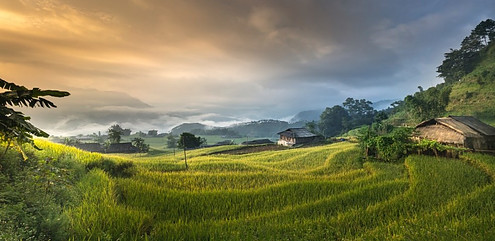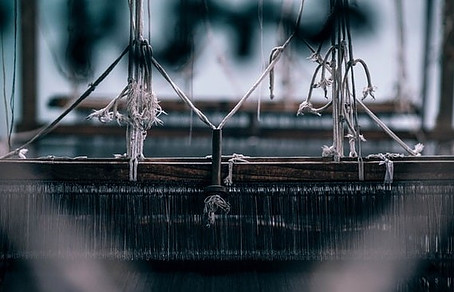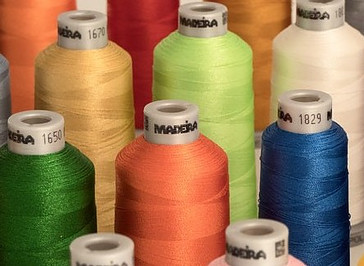Ethical sustainable clothing refers to garments that have been made from fabric that has been produced and sourced, using eco-friendly and sustainable farming practices. These would include crops and livestock that have been sustainably produced or fibers made from recycled materials. To get a better understanding of what ethical sustainable clothing is, we need to look at the farming and production methods used in producing fabrics and garments.

What is Sustainable Agriculture?
Sustainable agriculture is farming in a way based on an understanding of ecosystems. It also considers the relationships between organisms and their environment.
Sustainable farming is an efficient and productive way, but at the same time also a competitive way, to produce safe and high quality agricultural products. It protects and improves the natural environment, the economic and social conditions of the farmers and their families. Thus also, in turn, the employees and local communities.
Sustainable agriculture safeguards the health and welfare of the farmer and of the plant and animal species involved. A company like Allbirds is using sustainable wool to produce footwear.
Sustainable agriculture at the end of the day seeks to sustain farmers, communities and resources. It is done by promoting farming practices and methods that are profitable, environmentally sound and also good for communities.
What are the Elements of Sustainable Farming?
The main elements of sustainable farming would include economic, social and environmental considerations.
1. Economic: the crops and varieties that are being cultivated should be suited to the local growing conditions. The farming system should be economically viable for the local farmer. The net farm income must be adequate to provide the farmer with an acceptable standard of living. The ultimate goal being one which ensures an annual investment, which enables and facilitates improvement in the productivity of the soil, water conditions, other vital resources and the well-being of the farmers involved. 
2. Social: poverty and low social conditions can hinder farmers in effectively growing crops and looking after livestock. Sustainable agriculture aims to improve the well-being of farmers and rural communities while ensuring and creating employment. For sustainable farming to survive, it must be able to facilitate the building of a strong rural social infrastructure.
3. Environment: the overall environmental objective of sustainable agriculture is to preserve natural resources, whilst using ongoing and sustainable practices. Water sources for irrigation need to be sustainable.
In areas where soil erosion is a problem, it should be tackled by incorporating proven methods of combating this problem. Soil productivity and fertility should be maintained by introducing natural and harmonious techniques to “feed” and enrich the soil.
Sustainable farming increases the biodiversity of the area, by providing a variety of organisms with healthy and natural environments to live in. The natural habitat of animals and plants must not be threatened by the growing of crops. If pesticides and fertilizers are being used, these must be stored and disposed of safely and any impact on the local environment kept to a minimum. (climate change should be reduced.)
Where We Came From….
For thousands of years the textile industry was making use of only natural fibers such as cotton, silk and wool as the raw materials. Dyes were all natural using plant based substances and/or animal byproducts. The final product was hand spun and hand made.
 The Industrial Revolution changed all of that with the development of synthetic fibers and chemical dyes and machines to do the spinning and weaving of cloth.
The Industrial Revolution changed all of that with the development of synthetic fibers and chemical dyes and machines to do the spinning and weaving of cloth.
After the arrival of man-made fibers, the textile industry changed tremendously. Today polyester is the synthetic fiber that is used the most in the clothing sector.
Man-made fibers dominate the textile industry because of their low cost compared with natural fibers. It today represents 70% of global textile production. The pollution caused by the textile industry is detrimental to the environment and is just as harmful as the resources that it consumes.
Thirty five percent of global plastic microfibers in the ocean come from the clothing industry. When polyester fabric is washed, both in the factory and in domestic machines, it sheds microfibers that end up in the waterways and our oceans. These pollutants are currently been eaten by various forms of sea life. This in turn are finding their way into the human food chain.
Where We Are Going To…..
The global textile industry provides employment to millions of people around the world. From the growing to the spinning and weaving of fabrics, to the manufacturing of garments. Different cultures and countries follow different practices and there are rules and regulations in place to safeguard workers.
 The textile industry is one of the largest in the world, making sustainability an important factor and concept. Companies have the opportunity to make big differences on an environmental, social and economic level. “Reduce, reuse and recycle” are important concepts in sustainability.
The textile industry is one of the largest in the world, making sustainability an important factor and concept. Companies have the opportunity to make big differences on an environmental, social and economic level. “Reduce, reuse and recycle” are important concepts in sustainability.
Recycling of ocean plastic waste and post consumer plastic bottles, are used by brands like Vitamin A and Laara Swim, a Danish company, to produce sustainable swimwear using recycled materials.
There is a very high demand for water in the production of textiles, from the growing of crops to the dying and finishing of fabrics. Textile manufacturing uses a great amount of energy and creates environmental issues, such as water pollution and toxic chemicals in contaminated waters.
Many industries worldwide are working towards reducing their carbon footprint. Thus, the textile industry needs to look at more sustainability driven transformations. Sustainable fashion through the innovation of new fabrics, such as organic cotton brushed velvet and structured organic cotton denim is already happening. Nudie Jeans is an environmentally conscious Swedish brand that uses organic cotton to produce sustainable denim jeans.
Best Brands that Produce Ethical Sustainable Clothing
These are some of the ethical and sustainable brands that are helping the planet:
- Allbirds produce sustainable footwear and apparel using only natural, sustainable fabrics and recycled materials.
- Thought is an all-natural company that produces timeless fashion using organic cotton and sustainable fabrics.
- Laara Swim, a Danish company, is one of the 100% sustainable designer bikinis brands. They use fabric made from regenerated plastic waste that is found in the North sea, Adriatic sea and Mediterranean.
- Vitamin A produce sustainably made swimwear and leisure wear clothing using recycled nylon and natural fibers.
- Nudie Jeans is an environmentally conscious Swedish fashion brand that use organic cotton to produce sustainable denim jeans.
- Beaumont Organics is a British based Organic and Ethical clothing company that was started in 2008. They create contemporary conscious clothing for the modern woman.
- Soul Flower is an Organic Boho Hippy Clothing Range that is based in Minneapolis, USA. You can respect our planet while at the same time expressing your bohemian spirit.
- PrAna is an ethical North American company that only use sustainable fabrics and ethical practices. They do a full range of yoga, climbing, hiking, travelling and active wear for men and women.
- Oliver & Rain make eco-friendly organic cotton baby products, using sustainable and ethical practices.
Ethical sustainable clothing is possible
Contemporary and versatile designs are now available while also respecting people and the planet. Affordable ethical clothing can make you feel and look good, without breaking the bank. Fast fashion has become part of modern day life, with garments only lasting a few washes before it is worn out and discarded. Paying more for quality products can be daunting, but more manufacturers are producing affordable ethical clothing.
Many companies are changing their business models to include a supply chain that have a lower environmental impact. That includes having better socio economic conditions for workers in the field and in factories. Consumers are increasing aware of the environmental impact of textile production. They are therefore asking for ethical sustainable clothing.
People Tree was one of the pioneers of sustainable and Fair Trade fabrics and fashion. Items I bought from them many years ago are still in my wardrobe looking good.
Related post: 19 Best Sustainable Fabrics You Should Know.
If you have any questions about ethical sustainable clothing, then please leave your comments below and I will get back to you.

I also never would have guessed they were making ethical sustaining fabric and fashion. This was very informative and eco friendly, in which I love. It really is about time we all did our part going green helping to save our planet. Thanks for the peek and opportunity to help out.
Thank you and I agree that we can all help to make a difference.
Nice Article ??? ??
You are welcome, thank you
Well, this is another insightful post and an eye opener. I am very ignorant about the hazards caused by the textile industry due to the domination of the synthetics. I think this ethical sustainable clothing is a game changer and going by the information on this post, I think it should be very well incorporated and be the dominating one. I’m an environmentalist and I hate anything that can contaminate or disrupt nature.
Since its already making waves in the textile industry and some companies are adapting to its usage already, I think all that requires is a few more years before it gets back to the peak.
As more consumers are asking for ethical clothing, producers will hopefully be moving towards filling that demand. Because synthetic fabrics are often very cheap to produce, it is unfortunately also going to be around.
This was a fascinating and thought provoking article. I knew that a huge chunk of our clothing was man made materials, but I hadn’t realized the environmental impacts went way beyond manufacturing! I had no idea that microfibers were released every time we wash man made textiles, and that those microfibers end up in the water system. That is really scary, and I think more people need to understand the far reaching effects of these choices on our planet, and ultimately, on ourselves!
I would like to think that ethical sustainable clothing IS possible, as you maintain in your article. I am willing to pay more for quality, sustainable clothing when I can, but often, availability of options and financial limitations make it very difficult. However, as more people realize the long term economic impact of the damage to our environment and our health, hopefully more governments and companies will work to support the farmers and textile makers who are trying to do things the RIGHT way, and make more of these products available to the public.
Thank you for the article!
You are so right Brooke. Let’s hope that governments and producers will work together to make ethical and sustainable clothing more affordable to the masses.
Great article! I had no idea that polyester shed fibers like that – not that I have a ton of clothing made with polyester, but it does tend to show up in blended materials a lot. I would love to see a list of companies that are using more sustainable practices! I tried clicking on your link for People Tree, but it appears to be broken 🙁
Hi Sara, thank you for pointing out the broken link to me, I have now changed it so hopefully you should be able to access it
I’ve heard the term ethical sustainable clothing thrown around here and there, but never put too much thought into it. I knew that producing clothing and farming methods that’s involved with it impact the environment, but I didn’t/don’t have any real understanding of it, but this has given me a better idea of what it means and the importance of it. Maybe a few years down the road more clothing will be considered to be produced from sustainable farming practices.
As you mentioned, there are businesses changing up their models and I expect that to continue.
Yes let’s hope Nate that more ethical sustainable fabric can be produced.